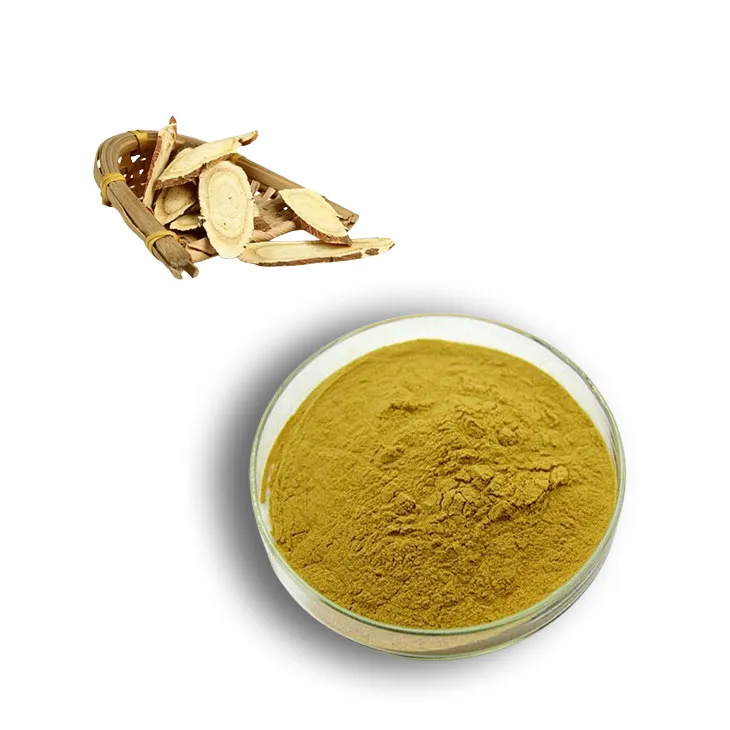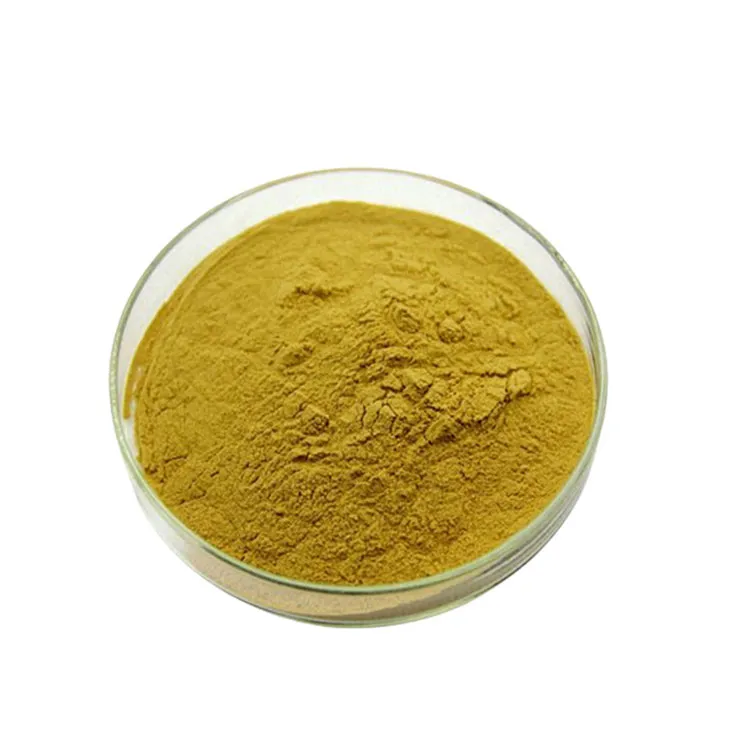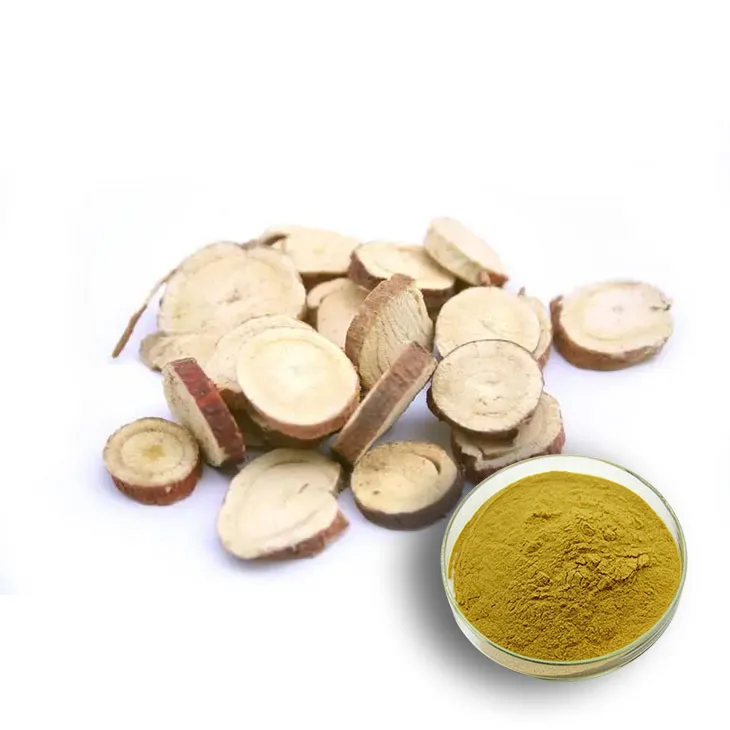- 0086-571-85302990
- sales@greenskybio.com
The process of extracting glycyrrhetinic acid from licorice root from licorice root extract powder.
2024-11-27

1. Introduction
Licorice root has been widely used in traditional medicine for centuries due to its numerous health - promoting properties. Glycyrrhetinic acid, one of the important bioactive components in licorice root, has attracted significant attention in various fields such as medicine, cosmetics, and food. Extracting glycyrrhetinic acid from Licorice Root Extract Powder is a complex but highly valuable process. Licorice Root Extract Powder is rich in a variety of compounds, and isolating glycyrrhetinic acid requires a series of well - designed steps and the application of advanced technologies.

2. Licorice Root and Its Extract Powder
2.1 Licorice Root
Licorice root, scientifically known as Glycyrrhiza glabra, is a perennial herb native to the Mediterranean region, Central Asia, and parts of Russia. It contains a wide range of bioactive substances, including flavonoids, triterpenoids, and polysaccharides. These substances contribute to its anti - inflammatory, antioxidant, and antiviral properties.2.2 Preparation of Licorice Root Extract Powder
The extraction of licorice root extract powder is the first step in the process of obtaining glycyrrhetinic acid. Typically, the licorice root is first dried and then ground into a fine powder. This powder is then subjected to extraction using solvents such as ethanol or water. The choice of solvent depends on various factors, including the solubility of the target compounds and the intended use of the extract. After extraction, the solvent is removed through evaporation, leaving behind the licorice root extract powder.
3. Pretreatment of Licorice Root Extract Powder
3.1 Filtration
Filtration is an essential step in the pretreatment of licorice root extract powder. The extract powder may contain insoluble particles, such as cell debris and undissolved fibers. These particles can interfere with subsequent extraction steps. By passing the extract through a filter, these insoluble materials can be removed, resulting in a cleaner and more homogeneous sample. Different types of filters can be used, depending on the size of the particles to be removed. For example, a filter with a small pore size can be used to remove fine particles, while a coarser filter may be sufficient for larger debris.3.2 Concentration
Concentration is another important pretreatment step. The initial extract may be relatively dilute, and concentrating it can increase the efficiency of subsequent reactions. There are several methods for concentrating the extract, such as rotary evaporation. In rotary evaporation, the extract is placed in a round - bottomed flask and heated under reduced pressure. The solvent evaporates, leaving behind a more concentrated sample. This concentrated sample is more suitable for further processing to extract glycyrrhetinic acid.
4. Chemical and Enzymatic Reactions for Glycyrrhetinic Acid Extraction
4.1 Chemical Reactions
Chemical reactions play a crucial role in converting the related compounds in the licorice root extract into glycyrrhetinic acid. One common approach is hydrolysis. For example, glycyrrhizin, which is present in licorice root extract, can be hydrolyzed to produce glycyrrhetinic acid. This hydrolysis reaction may be catalyzed by acids or bases. However, careful control of reaction conditions such as temperature, pH, and reaction time is necessary to ensure high yield and purity of glycyrrhetinic acid. If the reaction conditions are not properly controlled, side reactions may occur, leading to the formation of unwanted by - products.4.2 Enzymatic Reactions
Enzymatic reactions offer an alternative and often more specific method for extracting glycyrrhetinic acid. Enzymes such as β - glucuronidase can be used to selectively hydrolyze glycyrrhizin to glycyrrhetinic acid. The advantage of enzymatic reactions is their high specificity, which can reduce the formation of by - products. However, enzymatic reactions also require specific reaction conditions, including the optimal temperature, pH, and enzyme concentration. Additionally, the cost of enzymes may be a factor to consider in large - scale production.
5. Advanced Extraction and Purification Technologies
5.1 Supercritical Fluid Extraction
Supercritical fluid extraction (SFE) has emerged as a powerful technique in the extraction of glycyrrhetinic acid. Supercritical fluids, such as supercritical carbon dioxide ($CO_{2}$), possess unique properties that make them ideal for extraction. Supercritical $CO_{2}$ has a low critical temperature and pressure, which allows for the extraction of heat - sensitive compounds without degradation. It also has a high diffusivity and low viscosity, enabling it to penetrate the sample matrix quickly and efficiently. In the extraction of glycyrrhetinic acid from licorice root extract powder, supercritical $CO_{2}$ can be used in combination with appropriate modifiers (such as ethanol) to enhance the solubility of the target compound. SFE offers several advantages over traditional extraction methods, including higher extraction efficiency, shorter extraction time, and the production of a cleaner extract.5.2 Membrane Separation
Membrane separation is another advanced technology that can be used in the purification of glycyrrhetinic acid. Membranes with different pore sizes can be used to separate glycyrrhetinic acid from other compounds in the extract based on their molecular size. For example, ultrafiltration membranes can be used to remove larger molecules, while nanofiltration membranes can be used to further purify glycyrrhetinic acid by removing smaller impurities. Membrane separation is a relatively gentle process that can maintain the integrity of the target compound. It also has the potential for continuous operation, which is beneficial for large - scale production.6. Purification and Characterization of Glycyrrhetinic Acid
After the extraction of glycyrrhetinic acid, purification is necessary to obtain a high - purity product.
Purification methods may include recrystallization, chromatography (such as column chromatography or high -
performance liquid chromatography, HPLC), and distillation. Recrystallization involves dissolving the
impure glycyrrhetinic acid in a suitable solvent and then allowing it to slowly crystallize out, leaving
behind the impurities in the solvent. Chromatography techniques are more powerful for separating closely
related compounds. HPLC, in particular, can provide high - resolution separation and quantification of
glycyrrhetinic acid.
Characterization of the purified glycyrrhetinic acid is also important. Techniques such as nuclear magnetic
resonance (NMR) spectroscopy, mass spectrometry (MS), and infrared (IR) spectroscopy can be used to
determine the chemical structure and purity of glycyrrhetinic acid. NMR spectroscopy can provide detailed
information about the chemical environment of atoms in the molecule, while MS can determine the molecular
weight and fragmentation pattern of the compound. IR spectroscopy can be used to identify functional
groups present in glycyrrhetinic acid.
7. Applications of Glycyrrhetinic Acid
7.1 In Medicine
Glycyrrhetinic acid has a wide range of applications in medicine. It has been shown to have anti - inflammatory properties, which can be useful in the treatment of various inflammatory diseases such as arthritis. It also has potential antiviral and antibacterial activities. Additionally, glycyrrhetinic acid can modulate the immune system, which may be beneficial in certain immune - related disorders.7.2 In Cosmetics
In the cosmetics industry, glycyrrhetinic acid is used for its skin - whitening, anti - aging, and anti - inflammatory properties. It can be added to creams, lotions, and serums to improve skin health and appearance. For example, it can help to reduce hyperpigmentation and wrinkles, and soothe irritated skin.7.3 In Food
Glycyrrhetinic acid can also be used in the food industry as a natural flavor enhancer and preservative. It can impart a sweet taste to food products without adding excessive calories. However, its use in food is regulated due to potential health concerns at high doses.8. Conclusion
The process of extracting glycyrrhetinic acid from licorice root within licorice root extract powder is a multi - step and complex process. It involves the preparation of licorice root extract powder, pretreatment of the extract, chemical or enzymatic reactions for conversion, advanced extraction and purification technologies, and final purification and characterization of the product. Each step plays an important role in obtaining high - quality glycyrrhetinic acid. With the increasing demand for glycyrrhetinic acid in various industries, further research is needed to optimize the extraction process, improve the yield and purity of the product, and explore new applications of this valuable bioactive compound.
FAQ:
What are the main bioactive substances in licorice root?
Licorice root contains various bioactive substances. Glycyrrhetinic acid is one of the important ones. It also contains flavonoids, polysaccharides and other substances which may have antioxidant, anti - inflammatory and other biological activities.
Why is the pretreatment of licorice root extract powder necessary?
The pretreatment of licorice root extract powder is necessary. Filtration can remove impurities and insoluble substances, and concentration can increase the content of target substances in the sample. This makes the subsequent steps of extracting glycyrrhetinic acid more efficient and can improve the purity of the final product.
What are the advantages of using supercritical fluid extraction in the process of extracting glycyrrhetinic acid?
Supercritical fluid extraction has several advantages. It can operate at relatively low temperatures, which helps to protect the thermally sensitive components in the extract. It also has high selectivity, which can selectively extract glycyrrhetinic acid from the complex mixture in licorice root extract powder. Moreover, it is environment - friendly and can produce a relatively pure product.
How does enzymatic reaction help in the conversion to glycyrrhetinic acid?
Enzymatic reactions can be used to catalyze the conversion of related compounds in licorice root extract to glycyrrhetinic acid. Enzymes are highly specific catalysts. They can specifically recognize and act on certain chemical bonds or functional groups in the substrate molecules in the extract, promoting the transformation of precursor substances into glycyrrhetinic acid with high efficiency and selectivity.
What are the industrial uses of glycyrrhetinic acid?
Glycyrrhetinic acid has a wide range of industrial uses. In the pharmaceutical industry, it can be used as an ingredient in drugs for its anti - inflammatory, anti - ulcer and other pharmacological effects. In the cosmetics industry, it can be added to cosmetics for skin care, such as anti - aging and anti - irritation. It is also used in the food industry as a flavor enhancer and preservative.
Related literature
- Extraction and Characterization of Glycyrrhetinic Acid from Licorice Root: A Review"
- "Efficient Extraction of Bioactive Compounds from Licorice Root: Focus on Glycyrrhetinic Acid"
- "The Role of Advanced Technologies in the Isolation of Glycyrrhetinic Acid from Licorice Root Extract"
- ▶ Hesperidin
- ▶ Citrus Bioflavonoids
- ▶ Plant Extract
- ▶ lycopene
- ▶ Diosmin
- ▶ Grape seed extract
- ▶ Sea buckthorn Juice Powder
- ▶ Fruit Juice Powder
- ▶ Hops Extract
- ▶ Artichoke Extract
- ▶ Mushroom extract
- ▶ Astaxanthin
- ▶ Green Tea Extract
- ▶ Curcumin
- ▶ Horse Chestnut Extract
- ▶ Other Product
- ▶ Boswellia Serrata Extract
- ▶ Resveratrol
- ▶ Marigold Extract
- ▶ Grape Leaf Extract
- ▶ New Product
- ▶ Aminolevulinic acid
- ▶ Cranberry Extract
- ▶ Red Yeast Rice
- ▶ Red Wine Extract
-
Red Wine Extract
2024-11-27
-
Oyster Mushroom Extract Powder
2024-11-27
-
Licorice Root Extract Powder
2024-11-27
-
Curcumin
2024-11-27
-
Andrographis Paniculata Extract Powder
2024-11-27
-
Pueraria Lobata Extract
2024-11-27
-
Baicalin
2024-11-27
-
Garcinia Cambogia Extract
2024-11-27
-
Mango flavored powder
2024-11-27
-
Grapefruit Seed Extract Powder
2024-11-27




















